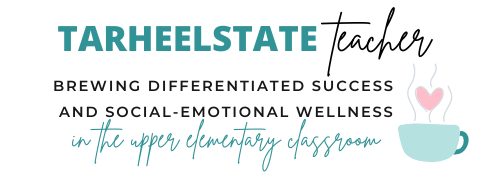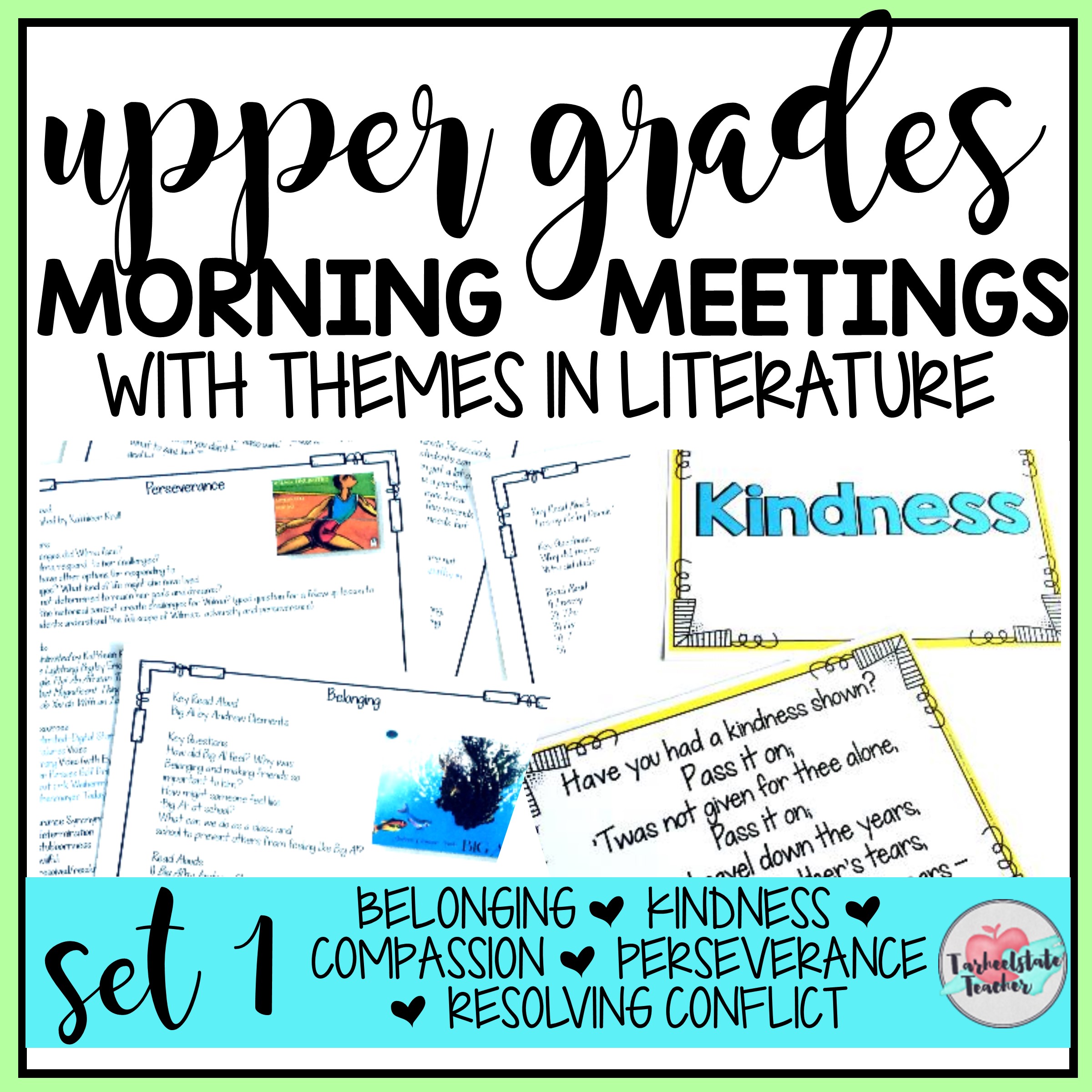Using Morning Meeting to Problem Solving Student Behavior and Issues
Utilizing morning meeting as a platform for solving classroom behavior problems and issues continues to be one of my TOP reasons for maintaining a morning meeting structure in my classroom. Today I'm sharing the simple process that I use to improve poor student behavior in the context of our classroom environment.
I'm talking about a lifesaver (like the flotation device kind) for those times when it seems that the class in general is falling apart.
Teachers often spend a lot of time setting expectations for classroom behavior, helping students develop and improve relationships with one another, and reflecting with students about how things are going at the beginning of the year.
We work really hard to fine-tune our machine for the first few weeks or months of school.
...And then we get busy and that classroom management ball that is so important often gets pushed aside.
I realized that dropping morning meeting was problematic (the first line of intervention for classroom behavior problems for me) and I blogged about it at Life, Love, Literacy a few years ago.
In that post, I confessed how we had stopped reflecting on classroom behavior and had stopped setting new goals. It went a little something like this:
"Well, one thing I realized is that I had dropped the ball on morning meeting.
With so many snow days and late starts, we stopped reflecting on our behavior and stopped setting new classroom goals to work towards.
Honestly, my kiddos repeat themselves every day when reflecting on morning meeting goals, we had achieved perseverance in math for the most part, and my kiddos are DARN NEAR perfect...
But hey, isn’t it better to give them the time to repeat themselves each morning--what went well yesterday, what needs to be better today--than for me to constantly have to repeat myself?"

You see, in that old blog post, I was taking the time to share how I had dealt with classroom behavior that was falling apart. You name it, I was dealing with it that month, and I WAS -OH-SO-DONE- with not addressing it and getting ourselves back on track.
This personal reflection (THAT I HAD DROPPED THE BEHAVIOR BALL AS THE TEACHER) led to a week's worth of morning meetings to rebuild our class community. We focused on problem-solving the issues we were having and strategies to improve students' overall behavior.
You can read more about that journey in the original post (and even pick up the FOCUS freebie that I designed based on our classroom meeting discussions that week).
Recall that one of my reasons for maintaining a morning meeting time routinely in my schedule is that I have found {again and again} that my students need it?
When I drop morning meetings as a routine, behavioral issues are soon to follow.
The moment I realized that students truly needed our "beginning of the year" dialogue to continue all~year~long, I dedicated myself to figuring out how to continue these important conversations.
> > >If I wanted to create true change in my students, I had to be dedicated to that goal all year long. Theme-based Morning Meetings are the perfect fit for our needs.

In that same {old} post, I reflected on a big shift in my behavior management:
"As I write this, I once again feel like I am doing "beginning of the year" stuff. But, I am starting to learn that kids need us to revisit "beginning of the year" lessons ALL YEAR LONG.
When I'm frustrated with my kiddos (behavior, learning, etc) I eventually come around to "what can I change to help them change?"
Based on students behavior and needs, you will have times when you need to step away from your “theme-based” morning meeting plans in order to address classroom issues.
Examples of Typical Classroom Issues that Pop Up:
too many students are blurting out, making it hard for others to learn
students are saving seats in the cafeteria
during independent work time, some students are chatting off-topic, goofing off, and/or not having a high level of focused, on-task time
students are arguing about rules for games at recess and bringing the drama back into the classroom
during group work, students are excluding, being rude, or taking over
and countless others that I’m sure you can think of!

How do we use morning meetings to improve on these behavioral issues?
First, I choose a student leader to guide the discussion. I find that strategically choosing a student who would benefit from having a leadership role focused on behavior and allowing them to lead the meetings for a few weeks is extremely beneficial as I try to correct behaviors. If my students are overall behaving appropriately, I may choose to allow a different student to be the leader each time I go through this reflection process. Students sit in a circle during this time so that they can see one another and look at the speaker.
I provide my student leader with question stems to help them guide the discussion. (I wrote these on an index card at first and also post them in the classroom by our meeting space.) Here's a typical student-led dialogue:
“As a classroom community, we are working on: walking down the hall silently and in a straight line.”
"How did we do yesterday?"
Students raise their hand and the leader calls on them. I step back from the conversation, but early on, I make sure to model how to encourage students to elaborate on their answers. I often chime in, "Rebecca, make sure they tell you WHY they think we did a good job yesterday." Elaboration is key in this process. You really want specific examples of how they did or did not do well on their goal so that the whole class hears what worked and what needs to change.
"What can we do today to make improvements?”

It truly is that simple and the power is in having STUDENTS verbalize how things are going.
Often, the culprits speak up and admit they need to improve. Students who are frustrated get an appropriate outlet for airing their frustrations, and while this may not immediately change their classmates' behaviors, I do think it helps them deal with the stress of a less than perfect learning environment.
I love this reflective routine and have needed to use it regularly with some groups of students. If you have a lengthier block of time for morning meeting or your students show you that they need consistent reflection in order to make improvements, you may find it beneficial to implement this strategy daily.
I encourage you to choose no more than two goals to focus on as a class. If possible, stick with the one that is most detrimental to your classroom environment until that issue improves.
At some point, I will ask students if they feel that we are ready to move on from the goal we are working on. I remind them that we can always come back to it later in the year if needed.
If you find that students are continuously reflecting that the class as a whole did not make improvements, please look for additional strategies and tools to offer them to help change happen.

I’m not a big fan of rewarding students with parties and such for good behavior (although I have, of course, resorted to setting goals for earning reward parties in my classroom). If it takes offering something that you believe students will strive for, then go for it! If they improve on a classroom goal that was challenging for the whole class to work together on, then perhaps a celebration is due!
Do you want to make goal setting a regular part of your classroom meeting routine?
Each Morning Meeting Made Easy theme set contains a header for setting a goal within each theme unit and a header for general classroom community goals. I print these on colored paper. We design a goal together and write it on the header along with the date that we set the goal. It would be great to post your goals somewhere in the room as a record and timeline of all you have strived to improve during the year and as a reminder when it seems like students have fallen back on old habits.
I hope this {easy} reflection process comes in handy for you this year! It surely helps me keep my sanity when things are not going so well in the classroom. I love to hear students' reflections.
Realizing that students are still learning to control themselves, I am appreciative when they are able to reflect on their mishaps and focus on improvement. I can give them grace, they can verbalize their desire for improvement, and we can turn our attention back to learning!
Want to grab copies of the free discussion frames to use in your morning meetings?
Other Posts in the Implementing Morning Meeting Series: Introduction to the Series
→ Post 1: Why I Devote Time to Classroom Meetings
→ Post 2: The Design: An Overview
→ Post 3: Why a Theme-Based Morning Meeting?
→ Post 4: Morning Meeting: Materials and Resources
→ Post 5: Launching Morning Meeting at the BOY
→ Post 6: Day by Day in the Morning Meeting
→ Post 7: Scheduling Classroom Meetings
→ Post 8: I Still Can't Fit it all In: Finding time for Morning Meetings
→ Post 10: Justifying Your Morning Meetings (with the standards!)

SHOP THE RESOURCES:





